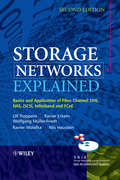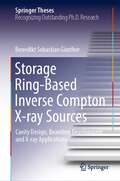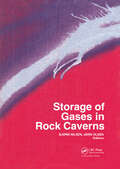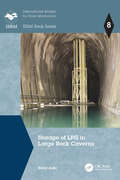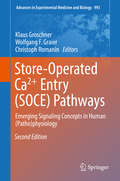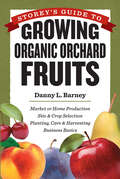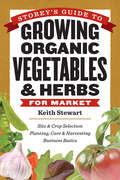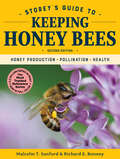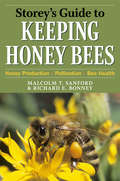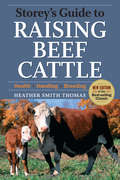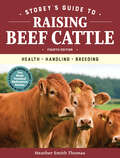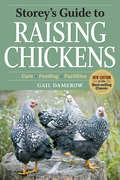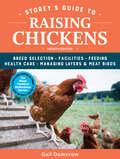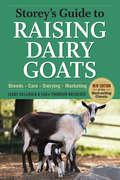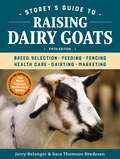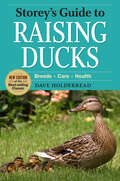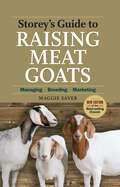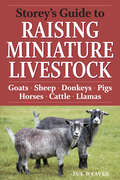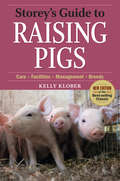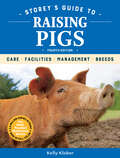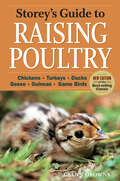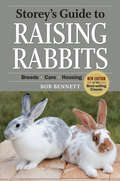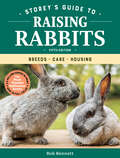- Table View
- List View
Storage Networks Explained
by Wolfgang Mueller-Friedt Ulf Troppens Rainer Erkens Rainer Wolafka Nils HausteinAll you need to know about Storage Area NetworksThe amount of data of an average company doubles every year. Thus, companies who own 1TB of data today will own 32TB in five years. Storage networks help to tame such data quantities and to manage this data growth efficiently. Since stored data and information are the biggest asset of any company, anyone who is involved in the planning or the operation of IT systems requires a basic knowledge of the principle and the use of storage networks.Storage Networks Explained covers the fundaments, techniques and functions of storage networks such as disk subsystems, Fibre Channel SAN, Internet SCSI (iSCSI), Fibre Channel over Ethernet (FCoE), Network Attached Storage (NAS), file systems, and storage virtualization. Furthermore the authors describe the use of these techniques and how they are designed to achieve high-availability, flexibility, and scalability of data and applications. Additional attention is given to network backup and the management of storage networks. Written by leading experts in the field, this book on storage area networks is updated and fully revised.Key features:Presents the basic concepts of storage networks, such as I/O techniques, disk subsystems, virtualization, NAS and SAN file systemsCovers the design of storage networks which provide flexible, highly-available, and scaleable IT systemsExplains the use of storage networks for data sharing, data protection, and digital archivingDiscusses management of storage networks using SNMP, SMI-S, and IEEE 1244This book provides system administrators and system architects, as well as students and decision makers, with the tools needed for optimal selection and cost-effective use of storage networks.The Linux Journal awarded the first edition with the "Editor's Choice Award 2005" in the category "System Administration Book."
Storage Ring-Based Inverse Compton X-ray Sources: Cavity Design, Beamline Development and X-ray Applications (Springer Theses)
by Benedikt Sebastian GüntherThis thesis presents research on novel laboratory-scale synchrotron X-ray sources based on inverse Compton scattering and applications of their X-ray radiation using the Munich Compact Light Source (MuCLS) as an example. It provides an introduction to the theory of this laser-electron interaction, laser resonators and X-ray interactions with matter. On this basis, upgrades to the laser system including the development of a new laser optic, X-ray beam stabilisation and two techniques for fast X-ray energy switching of inverse Compton sources are presented. On the application side, the beamline, designed and developed for the inverse Compton X-ray source at the MuCLS, is described before various techniques and applications are demonstrated at this laboratory-scale synchrotron X-ray facility. Among them are K-edge subtraction imaging, X-ray phase contrast imaging and X-ray absorption spectroscopy. Additionally, a new X-ray microscopy technique, called full-field structured-illumination super-resolution X-ray transmission microscopy, is presented.Apart from research conducted at the MuCLS, this thesis contains an in-depth overview on the state of the art of the various types of inverse Compton X-ray sources that have been realised so far. Accordingly, this thesis may serve as a guide and reference work for researchers working with inverse Compton X-ray sources as well as future users of such devices.
Storage of Gases in Rock Caverns: Proceedings of the International Conference on Storage of Gases in Rock Caverns/Trondheim/26-28 June 1989
by BJØRN NILSEN; JØRN OLSENContains papers of a conference on [title] held in Trondheim, Norway, June 1989. The following storage concepts are considered: pressurized, compressed air energy, air cushion surge chambers, amonia products storage.
Storage of LPG in Large Rock Caverns (ISRM Book Series)
by Kenji AokiThis book uses actual construction projects as examples to elaborate the various technologies regarding groundwater control and air-tightness guarantees for the construction of large storage rock caverns in complicated geological conditions. It introduces the latest technologies to give hands-on experience of what to do in unexpected geological conditions, and provides insight into the design, construction and operation of underground facilities. The book is hence useful in feasibility studies, developments and other research into these underground facilities. Drawing on the experience gained from building Japan's largest LPG storage caves, Storage of LPG in Large Rock Caverns is a must-read for engineers, academics and students in the fields of rock mechanics, geotechnical engineering and related disciplines.
Store-Operated Ca²⁺ Entry (SOCE) Pathways
by Klaus Groschner Christoph Romanin Wolfgang F. GraierStore-operated Ca2+ entry (SOCE) serves to control essential functions throughout the human body and represents a novel and attractive target for therapeutic intervention. This book provides an extensive overview of the role of SOCE pathways in Molecular Physiology and Cell Biology, as well as their clinical significance. (Patho)physiological principles and emerging therapeutic strategies are delineated in a way that is valuable both for the education of graduate students in advanced Cell Biology/Molecular Physiology and for the promotion of innovative research and developments in the clinical/therapeutic fields. A comprehensive, clear and elaborate representation of current concepts is provided, including a pathophysiological section arranged in a tissue/organ/system-oriented manner. The book is intended for basic researchers specializing in cell signaling, ion transport, or pharmacology, as well as biomedical scientists and clinicians with a focus on immunology, neurology or cardiology.
Storey's Guide to Growing Organic Orchard Fruits: Market or Home Production * Site & Crop Selection * Planting, Care & Harvesting * Business Basics (Storey's Guide To Ser.)
by Danny L. BarneyDanny Barney covers everything you need to know to successfully grow and market your own organic orchard fruits. Offering expert tips on selecting the right site, choosing the best cultivars, designing and maintaining a sustainable orchard, and efficiently harvesting fruit, Barney also helps you develop a viable business plan, acquire necessary organic certifications, and identify niche markets for your products.
Storey's Guide to Growing Organic Vegetables & Herbs for Market: Site & Crop Selection * Planting, Care & Harvesting * Business Basics
by Keith StewartKeith Stewart covers everything you need to know to successfully grow and market your own organic vegetables and herbs. Offering expert tips on choosing a growing site, soil fertility, companion planting, irrigation, organic farming techniques, dealing with pests, and harvesting, Stewart also helps you design a business plan, manage employees, and find niche markets for your produce.
Storey's Guide to Keeping Honey Bees, 2nd Edition: Honey Production, Pollination, Health (Storey’s Guide to Raising)
by Richard E. Bonney Malcolm T. SanfordThis trusted handbook is a must-have for novice and seasoned beekeepers alike. Now totally redesigned and featuring color photos and graphics, the second edition also includes up-to-date information on honey bee health. The go-to reference presents comprehensive yet accessible information on everything from planning hives and installing a colony to preventing disease and managing productive hives that will bear bountiful honey harvests year after year. This publication conforms to the EPUB Accessibility specification at WCAG 2.0 Level AA.
Storey's Guide to Keeping Honey Bees: Honey Production, Pollination, Bee Health (Storey’s Guide to Raising)
by Richard E. Bonney Malcolm T. SanfordEnjoy the sweet rewards of keeping your own honey bees. Learn how to plan a hive, acquire bees, install a colony, keep your bees healthy, and harvest honey. Full of practical advice on apiary equipment and tools, this comprehensive guide also includes an overview of colony life and honey bee anatomy.
Storey's Guide to Raising Beef Cattle, 3rd Edition: Health, Handling, Breeding (Storey’s Guide to Raising)
by Heather Smith ThomasWhether you’re raising one cow or a herd, this comprehensive guide shows you everything you need to know to successfully manage your beef cattle operation. Heather Smith Thomas stresses the importance of understanding bovine behavior while covering breed selection, calving, feeding, housing, medical care, and humane slaughter practices. Along with in-depth information on raising grass-fed animals and dealing with toxic pasture plants, you’ll also find advice on creating a viable business plan and identifying niche markets for your beef.
Storey's Guide to Raising Beef Cattle, 4th Edition: Health, Handling, Breeding (Storey’s Guide to Raising)
by Heather Smith ThomasWhether a farmer is raising one cow or a herd, Storey&’s Guide to Raising Beef Cattle is the most reliable reference for ensuring a successful, healthy cattle operation. In this fully updated, full-color fourth edition, long-time cattle rancher and author Heather Smith Thomas explains every aspect of bovine behavior and provides expert guidance on breed selection, calving, feeding, housing, pasture, and health care. Along with in-depth information on raising grass-fed animals, there is also advice on creating a viable business plan and identifying niche markets for selling beef. This publication conforms to the EPUB Accessibility specification at WCAG 2.0 Level AA.
Storey's Guide to Raising Chickens, 3rd Edition: Care, Feeding, Facilities (Storey’s Guide to Raising)
by Gail DamerowGail Damerow shows you how to choose the right breeds for your needs, build efficient chicken coops, provide necessary medical attention for your animals, and much more. Whether you’re raising broilers for meat or preparing your chickens to win a blue ribbon at the next county fair, Storey’s Guide to Raising Chickens will help you achieve your poultry-raising goals.
Storey's Guide to Raising Chickens, 4th Edition: Breed Selection, Facilities, Feeding, Health Care, Managing Layers & Meat Birds (Storey’s Guide to Raising)
by Gail DamerowSerious poultry farmers and backyard bird raisers have relied on this best-selling reference for more than 20 years. The fourth edition of Gail Damerow’s comprehensive handbook is now completely revised and redesigned, making it more accessible and informative than ever. You’ll get the most up-to-date details on shelter, food, health care, eggs, chicks, and meat, and recent research into chicken behavior and communication makes the sections on flock management truly authoritative. New color photos and illustrations provide more specificity and information about chicken breeds, anatomy, and health.
Storey's Guide to Raising Dairy Goats, 4th Edition: Breeds, Care, Dairying, Marketing (Storey’s Guide to Raising)
by Jerry Belanger Sara Thomson BredesenA great choice for the small or backyard farmer, dairy goats require a smaller investment than cows and produce milk that makes delicious yogurt and cheese. This fourth edition includes more on pygmy goats, health care, breeding, and making dairy products. You’ll have everything you need to you need to know to successfully raise your own dairy goats.
Storey's Guide to Raising Dairy Goats, 5th Edition: Breed Selection, Feeding, Fencing, Health Care, Dairying, Marketing (Storey’s Guide to Raising)
by Jerry Belanger Sara Thomson BredesenThis best-selling handbook is packed with detailed information on housing, feeding, and fencing dairy goats. It’s been the trusted resource on the topic for farmers and homesteaders since it was originally published in 1975, and the new edition — completely updated and redesigned — makes Storey’s Guide to Raising Dairy Goats more comprehensive and accessible than ever. In-depth sections explain every aspect of milking, including necessary equipment, proper hand-milking techniques, and handling and storing the milk. New color illustrations show each stage of kidding, and substantial chapters on dairy goat health and breeding include the most up-to-date research and practices.
Storey's Guide to Raising Ducks, 2nd Edition: Breeds, Care, Health (Storey’s Guide to Raising)
by Dave HolderreadWith in-depth information on feeding, housing, behavior, and health care, this comprehensive guide also provides proven strategies for creating a profitable business plan and marketing your products. Whether you&’re about to acquire your first ducks or are interested in experimenting with rare breeds, Storey&’s Guide to Raising Ducks will help you achieve your duck-raising goals.
Storey's Guide to Raising Horses, 2nd Edition: Breeding, Care, Facilities (Storey’s Guide to Raising)
by Heather Smith ThomasRaising horses successfully requires good preparation, hard work, and a sincere interest in your animals’ well-being. With in-depth information on all aspects of horsekeeping, including grooming, foaling, housing, diet, exercise, and medical care, this comprehensive guide covers everything you need to know to raise healthy and happy horses.
Storey's Guide to Raising Horses, 3rd Edition: Breeding, Care, Facilities (Storey’s Guide to Raising)
by Heather Smith ThomasNow with full-color photography and illustrations throughout, the completely updated third edition of Storey&’s Guide to Raising Horses is the most comprehensive horse husbandry handbook available, whether you&’re a first-time owner or an experienced horse handler. Covering everything you need to know about facilities, breeding, and health care, this new edition features a photographic gallery of many types of horses; expanded material on recognizing, preventing, and treating a wide range of health issues, including insulin resistance, skin conditions, and digestive disorders; new vaccination protocols, including vaccinating for West Nile Virus; and updated information on breeding methods, foaling problems, and the care of broodmares and new foals. This publication conforms to the EPUB Accessibility specification at WCAG 2.0 Level AA.
Storey's Guide to Raising Meat Goats, 2nd Edition: Managing, Breeding, Marketing (Storey’s Guide to Raising)
by Maggie SayerDiscover how raising your own meat goats can be a fun and profitable endeavor. Offering plenty of tips for creating an economically viable operation and identifying niche markets for your products, Storey&’s Guide to Raising Meat Goats shows you how to care for a thriving and productive herd full of healthy and happy animals.
Storey's Guide to Raising Miniature Livestock: Goats, Sheep, Donkeys, Pigs, Horses, Cattle, Llamas (Storey’s Guide to Raising)
by Sue WeaverWhether you want to the make most of a small plot of land or add diversity to a large farm, raising miniature livestock can be a fun and profitable experience. With expert advice on choosing a breed that suits your needs, Sue Weaver shows you how to house, feed, and care for miniature goats, sheep, donkeys, pigs, horses, cattle, and llamas. You’ll be inspired by profiles of successful breeders as you learn everything you need to know to keep your miniature livestock healthy and productive.
Storey's Guide to Raising Pigs, 3rd Edition: Care, Facilities, Management, Breeds (Storey’s Guide to Raising)
by Kelly KloberLearn how to successfully raise your own pigs. Stressing the importance of sustainable and environmentally friendly farming practices, Kelly Klober provides expert tips on making your hog operation more efficient and profitable. Storey’s Guide to Raising Pigs will give beginners the confidence they need to succeed, while inspiring experienced farmers to try new techniques and experiment with new breeds.
Storey's Guide to Raising Pigs, 4th Edition: Care, Facilities, Management, Breeds (Storey’s Guide to Raising)
by Kelly KloberFarmer Kelly Klober provides expert advice on making any size hog operation more efficient and profitable in Storey’s Guide to Raising Pigs. The most comprehensive book available on the topic, this fourth edition features the most up-to-date information and practices, illustrated with color photography. Sustainable and environmentally friendly farming practices are stressed. Both beginners and experienced farmers will find all the information they need to select, house, care for, breed, and butcher pigs, along with marketing advice. This publication conforms to the EPUB Accessibility specification at WCAG 2.0 Level AA.
Storey's Guide to Raising Poultry, 4th Edition: Chickens, Turkeys, Ducks, Geese, Guineas, Game Birds (Storey’s Guide to Raising)
by Glenn DrownsWhether you’re running a farm or interested in keeping a few backyard birds, Storey’s Guide to Raising Poultry covers everything you need to know to successfully raise your own chickens, turkeys, waterfowl, and more. Stressing humane practices throughout, Glenn Drowns provides expert advice on breed selection, housing, feeding, behavior, breeding, health care, and processing your own meat and eggs. With tips on raising specialty species like doves, ostriches, and peafowl, you’ll be inspired to experiment with new breeds and add diversity to your poultry operation.
Storey's Guide to Raising Rabbits, 4th Edition: Breeds, Care, Housing (Storey’s Guide to Raising)
by Bob BennettWhether you’re interested in raising rabbits for show, meat, fur, or as pets, this comprehensive guide covers everything you need to know to keep your animals healthy and productive. Offering expert advice on breed selection, housing, feeding, humane handling, routine medical care, and dealing with diseases, Bob Bennett also provides tips on how to make raising rabbits a financial lucrative endeavor. Storey’s Guide to Raising Rabbits will help both the commercial producer and the backyard fancier achieve their rabbit-raising goals.
Storey's Guide to Raising Rabbits, 5th Edition: Breeds, Care, Housing (Storey’s Guide to Raising)
by Bob BennettThe fifth edition of this best-selling handbook features the same detailed approach that has made it the trusted source for raising healthy, productive rabbits — plus a total redesign with color photos and graphics. Whether you’re interested in raising rabbits for show, meat, fur, or as pets, this comprehensive guide offers expert advice on breed selection, housing, feeding, humane handling, and more. In addition, author Bob Bennett includes the most up-to-date information on preventive health care, treating diseases, marketing, and showing. This publication conforms to the EPUB Accessibility specification at WCAG 2.0 Level AA.
